A common way to monitor what insects or lizards are around, is to use a live-capture pitfall trap which skinks, geckos and ground-based insects then fall into. With lizards, slices of pear or sometimes petfood are used to attract them to the trap.
But lizards and insects might not be the only species to take an interest in pitfall traps. Predators can be attracted by both the bait and the easy meal of trapped lizard or insect within. Observing a trapped skink fall victim to an opportunist rat led researchers Christopher Woolley, Carey Knox and Michael Watson to evaluate how much their pitfall monitoring method was putting native species at risk.
Co-author Michael Watson observed predation of a skink from a pitfall trap during a lizard salvage (the removal of lizards from a location where activities may have a harmful effect on them or their habitat) at a future development site in urban Wellington.
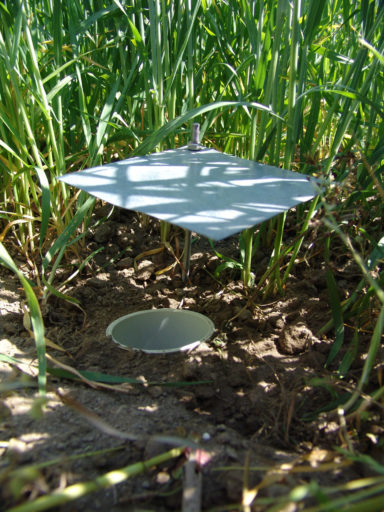
“At 2pm on 10 January 2019, a rat (possibly R. norvegicus) was observed foraging in a pitfall trap and emerging after around 10 seconds. Strong northerly winds likely prevented the rat becoming aware of the observer. When it emerged, the rat had a skink (likely O. polychroma, as this was the only species caught during the salvage) hanging laterally from its mouth, and quickly disappeared into the grass. A second rat of unknown species was seen at the site at around 10am on 11 January.”
As a result of these observations, two methods were used to assess predation of skinks at pitfall traps. The first aimed to quantify the amount of bait (tinned pear) being removed while the second aimed to confirm that rodents were responsible.
Although predator harvesting at pitfall traps had previously been observed, the extent to which it happened was unknown.
“While several studies investigate the efficacy of different trapping methods and risks to captured animals (e.g. dehydration, exposure, starvation, drowning and predation among captured animals), few examine predation upon trapped animals. In addition to presenting both ethical and methodological issues for ecologists, in some cases, predation of trapped animals may have implications for species conservation (e.g. predation of threatened species).”
Our rare skinks and geckos have enough challenges to survive – without us literally delivering them to predators on a plate! The extent of the risk probably depends on the density of predators at the study site, the trap design and how well the monitored species can defend themselves. More awareness of the risk may lead to new ways of reducing it.
“While some species have become extirpated from their historical ranges where predatory mammals have been introduced, many skink species classified as ‘At Risk’ or ‘Threatened’ under the Department of Conservation (DOC) Threat Classification System co-occur with varying densities of mammalian predators. Possible mammalian predators of lizards confined in traps in New Zealand are rats (kiore, Norway rats and ship rats), mice, mustelids (weasels, stoats and ferrets), hedgehogs, brushtail possums, cats, and dogs. Additionally, non-mammalian predators of lizards include native or introduced birds (e.g. weka), crabs (e.g. Leptograpsus variegatus), as well as other lizards.”
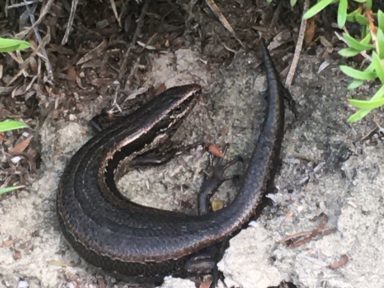
Two different methods of live trapping are commonly used to catch lizards in New Zealand, pitfall traps and funnel traps. With pitfall traps, a container is dug into the ground so that its opening is flush with the substrate. Funnel traps (also called gee-minnow traps), consist of a cylinder with a funnel inverted at one or both ends, so that it’s easy to get in but not out.
“When operational, traps must be checked daily and be fitted with covers to provide shade, and to prevent or reduce the risk of desiccation and predation. It is also recommended for pitfall traps that gap size between lid and substrate should be 10–20 mm. Traps must be removed or closed when not in use. Despite these measures, some predator species are able to enter funnel traps (e.g. mice and weasels), and access pitfall traps by squeezing under (e.g. mice and rats) or lifting (e.g. brushtail possums) trap covers.”
Predation of lizards has been seen or inferred from both types of traps on several occasions.
“In 2020, trapping at a scenic reserve on the Port Hills above Christchurch was discontinued after two days when six skinks were found dead in traps (5% of the total catch). A weasel was caught in a trap with the remains of two skinks, and the other four were killed by mice. Funnel trapping was also deemed unsuitable for monitoring the nationally critical white-bellied skink (Oligosoma hōparatea) in the mid-Canterbury high country after two skinks (one a white-bellied skink) were killed in traps by mice.”
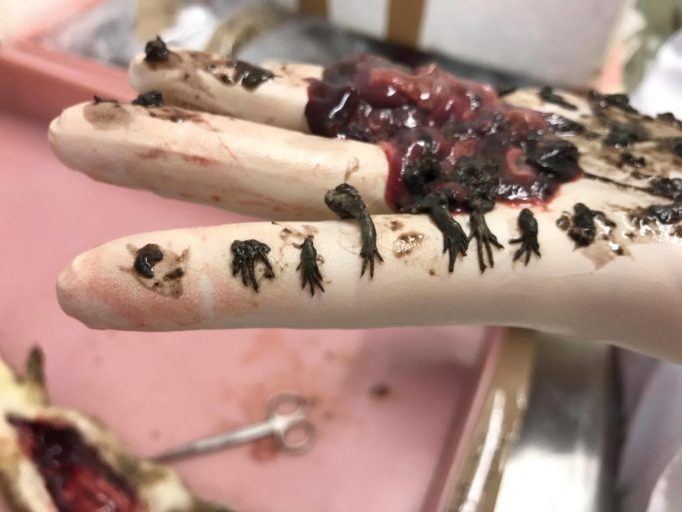
And what about the times when predators don’t leave any evidence or remains at the crime scene? We really know very little about how often predation is happening.
“Despite these observations there has been no prescribed research into rates of predation at, or visitation of, live traps in New Zealand by various predators. There has also been little research into rodent-exclusive trap design. Furthermore, given that the current knowledge of predation has largely relied upon the discovery of skink remains or rodent sign in traps, it is possible that the frequency of predation may currently be underestimated due to instances where no remains are left (i.e. where a lizard is removed from a trap or entirely consumed by the predator).”
The predator study was carried out at the same Wellington site as the initial ‘lizard salvage’.
“The six-day lizard salvage operation took place from 7 to 12 January 2019 at a coastal site in Wellington prior to the commencement of development work for a cycleway. Northern grass skinks (Oligosoma polychroma) were known to be present in moderate to high numbers at the site from earlier research. The salvage effort consisted of 323 traps at roughly 5 metre spacings deployed across a narrow (approx. 10 metre) 0.7 hectare strip of coastal scrubland.”
“The majority of traps used (298 traps) were 1.1 litre plastic pails (depth = 127 mm). The remaining 25 traps were 4 litre plastic pails (depth = 200 mm) previously installed at the site. Traps were buried in the substrate so that their openings were flush with the ground. Lids pegged above traps provided a gap of approximately 20 mm.”
The 6-day lizard salvage operation successfully captured, measured and marked 389 skinks which were translocated to two nearby release sites.
More tinned pears and some camera traps were also used to check out what was happening with local mammal predators.
“On 11 January 2019, pear was added to all traps between 11.30am and 1pm. These traps were checked in the same order between 3.30pm and 5pm the same day and then again between 11.30am and 2.30pm the following day, and the number of traps missing pear was recorded.”
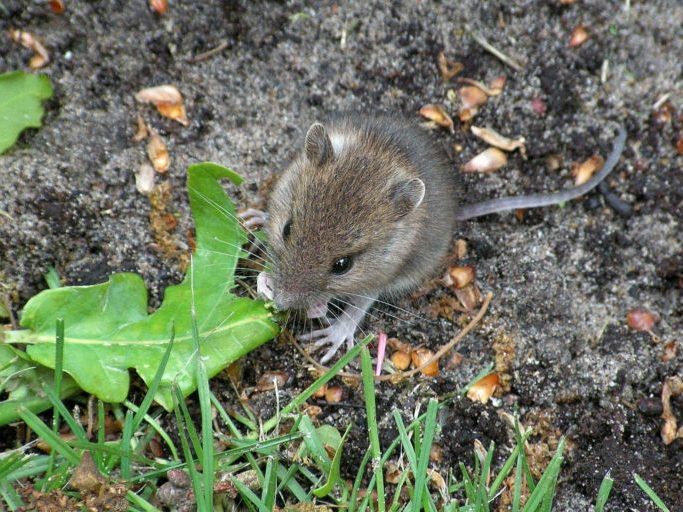
“On 1 February at 2pm, ten 1.1 litre pitfall traps (spaced approximately 5 metres apart) were opened at the site and baited with pear (Figure 1 white rectangle). Two motion-detecting cameras were set up approximately 1 metre from two different traps, tethered to vegetation at heights of c. 0.6 m above the ground. The cameras were set up to take five photos over five consecutive seconds when triggered. All the traps were checked for pear following each night and the cameras were collected after two nights on 3 February at 10 am. While rodents were detected during this two-day period, one of the cameras was not well centred on the trap (only the lid of the pitfall trap was in view) and so it was not possible to see animals entering the trap. For this reason, this camera was deployed for a further two nights (deployed: 4 February, retrieved: 6 February).”
Rapid bait loss occurred over the study period with 77% removed after 24 hours.
“Four hours after the 323 traps were baited, 89 (27.6%) were missing pear. After 24 hours, 250 traps (77.4%) were missing pear. Traps that had lost their bait seemed to be spatially clustered (exact locations were not mapped) but were found across the full extent of the 0.7 ha sampled area.”
The results from the motion-detecting cameras showed that rodents were visiting and, apart from eating the bait, were leaving the traps apparently undisturbed.
“Of the 10 traps that were reopened, only one was missing its pear after 2 nights. A camera at this trap recorded images of a mouse looking into and sitting on top of the trap on the first night (during which the bait was not removed) and a Norway rat at the trap on the second night (after which the bait was gone).”
The camera which had initially not been centred properly was left out for a further two nights with fresh bait.
“On the first night, a Norway rat was again observed at the trap for approximately one minute at 2.41am, though it did not enter the trap. On the second night a ship rat was detected at the trap multiple times between 10.28pm and 3.51am. At 10.29pm, it entered the trap (with its front half only) for around 5 seconds and removed the pear. Subsequent photos show the rat eating (presumably the pear). The following morning, apart from the absence of pear, the trap appeared undisturbed, with the lid not noticeably askew. The other camera did not record any images of animals near its trap.”
Instead of pear slices, those rodents might easily have discovered skinks.
“We recorded three forms of evidence of rodent interference at pitfall traps: direct observation of a rat depredating a trapped skink, the high rate of bait removal over a 24-hour period, and camera observations of three rodent species interacting with a trap – one of which removed bait. From these, we infer that multiple instances of predation from traps during this project were probable and, given the high number of skinks salvaged, the total number of skinks depredated from traps could have been substantial.”
Not good news for the skinks then and potentially even worse if the lizards being trapped had been a highly endangered species. It’s possible too that the resident rodents learnt over the course of the salvage operation, where an easy meal of pear (or skink) could reliably be found.
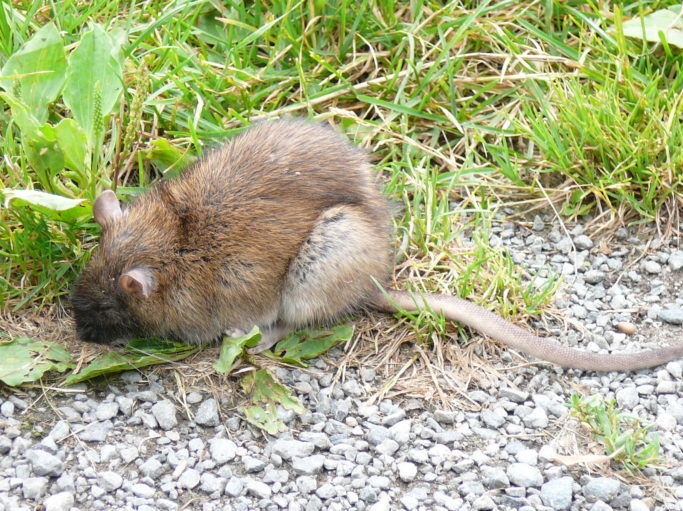
“We believe that over the course of the salvage the frequency of rodent visitation may have increased as individuals became accustomed to the traps and learned to forage in them. Replacing bait in the traps regularly likely enhanced the speed of learning by rewarding trap-entering behaviour.”
“We found no skink remains in our traps nor did we notice visible disturbance to traps that we knew had been accessed (e.g. cover ajar). Given this, it is possible that predation of lizards constrained in traps may often go undetected and unreported.”
So should researchers be using live-capture traps at all?
“Live trapping is an essential, highly effective tool for the salvage, survey, and monitoring of New Zealand lizards, for which there is often no feasible or comparably effective (in terms of the numbers that can be caught) alternative. The need for lizard surveys in areas where rodents and other mammals are uncontrolled is growing with increasing enforcement of legislation that requires wildlife surveys prior to development.”
How can live trapping be done differently then, to reduce the risks?
“We suggest that live trapping of lizards should not commence without prior understanding of predator densities (at least one night of standard rodent monitoring using tracking tunnels at 50 m spacing throughout the site). If tracking rates are high (e.g. >40% for mice or >20% for rats), then action should be taken reduce the likelihood of predation (e.g. more frequent clearance of traps, using unbaited traps). We also recommend that all lizard trapping programmes closely monitor and report trap disturbance, bait removal, lizard mortality, and if possible, trap visitation by potential predators, as a way to quantify the risk to captured lizards and their populations.”
What about different pitfall trap designs?
“Further research into methodologies that might reduce predation is also warranted. A variety of different trap designs are currently in use. Traps at which we observed foraging were small (127 mm deep) and had lids secured on two sides by metal pegs. Alternative designs may reduce the risk of predation (e.g. larger traps, heavier lids, use of metal or wire grates as recommended by Whitaker (1994)). The use of bait in live traps (e.g. tinned pear, banana or cat food) is widely used in New Zealand and, in general, has been shown to increase capture rate. However, it likely also attracts predators, and its use should consider the abundance of predators at a site.”
The full research report is published in the New Zealand Journal of Zoology. Only the abstract is freely available online to non-subscribers.
Evaluating the risk of predation for lizards constrained in live traps (2021)

